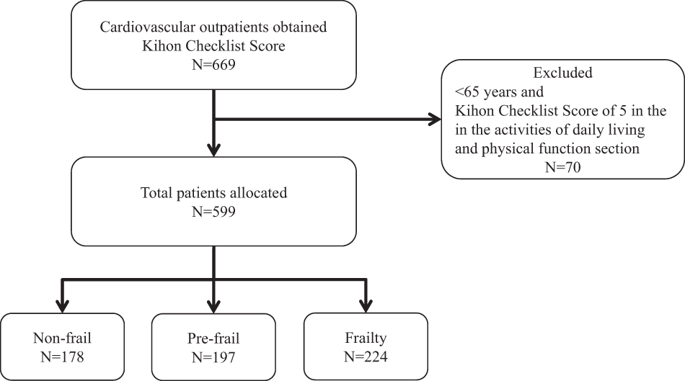当前位置:
X-MOL 学术
›
Hypertens. Res.
›
论文详情
Our official English website, www.x-mol.net, welcomes your
feedback! (Note: you will need to create a separate account there.)
Cardiovascular risk profile and frailty in Japanese outpatients: the Nambu Cohort Study
Hypertension Research ( IF 4.3 ) Pub Date : 2020-03-17 , DOI: 10.1038/s41440-020-0427-z Mitsuteru Matsuoka 1 , Taku Inoue 2, 3 , Tetsuji Shinjo 2 , Asuka Miiji 2 , Masahiro Tamashiro 4 , Kageyuki Oba 4 , Hisatomi Arima 3 , Osamu Arasaki 4
Hypertension Research ( IF 4.3 ) Pub Date : 2020-03-17 , DOI: 10.1038/s41440-020-0427-z Mitsuteru Matsuoka 1 , Taku Inoue 2, 3 , Tetsuji Shinjo 2 , Asuka Miiji 2 , Masahiro Tamashiro 4 , Kageyuki Oba 4 , Hisatomi Arima 3 , Osamu Arasaki 4
Affiliation

|
Epidemiologic findings indicate that unfavorable cardiovascular (CV) risk profiles, such as elevated systolic blood pressure (SBP), low-density lipoprotein cholesterol (LDL-C), and overweight, decelerate with aging. Few studies, however, have evaluated the association between the CV risk profile and frailty. We performed a cross-sectional analysis using the baseline data of a prospective cohort study. A total of 599 subjects (age, 78 [range: 70–83] years; men, 50%) were analyzed in an outpatient setting. Frailty was diagnosed in 37% of the patients according to the Kihon Checklist score. An unfavorable CV risk profile was associated with a lower risk of frailty. The adjusted odds ratios (ORs; 95% confidence interval [CI]) of each CV risk factor for frailty were as follows: SBP (each 10 mmHg increase) 0.83 (0.72–0.95), LDL-C (each 10 mg/dl increase) 0.96 (0.86–1.05), and body mass index (each 1 kg/m 2 increase) 1.03 (0.97–1.10). Moreover, the total number of CV risk factors within the optimal range was significantly associated with the risk of frailty with the following ORs (95% CI): 1, 2.30 (0.75–8.69); 2, 3.22 (1.07–11.97); and 3, 4.79 (1.56–18.05) compared with patients having no risk factors within optimal levels (p for trend 0.008). Abnormal homeostasis might lead to lower levels of CV risk factors, which together result in “reverse metabolic syndrome.” Our findings indicate that a favorable CV risk profile is associated with frailty.
中文翻译:

日本门诊患者的心血管风险状况和虚弱:南部队列研究
流行病学研究结果表明,不利的心血管 (CV) 风险状况,例如收缩压 (SBP) 升高、低密度脂蛋白胆固醇 (LDL-C) 和超重,会随着衰老而减速。然而,很少有研究评估 CV 风险状况与虚弱之间的关联。我们使用前瞻性队列研究的基线数据进行了横断面分析。在门诊环境中分析了总共 599 名受试者(年龄,78 [范围:70-83] 岁;男性,50%)。根据 Kihon Checklist 评分,37% 的患者被诊断为虚弱。不利的心血管风险状况与较低的虚弱风险相关。每个心血管虚弱风险因素的调整优势比(OR;95% 置信区间 [CI])如下:SBP(每增加 10 mmHg)0.83 (0.72–0.95),LDL-C(每增加 10 mg/dl)0.96 (0.86–1.05),体重指数(每增加 1 kg/m 2)1.03 (0.97–1.10)。此外,最佳范围内的心血管风险因素总数与虚弱风险显着相关,以下 OR(95% CI):1, 2.30 (0.75–8.69);2, 3.22 (1.07–11.97); 和 3, 4.79 (1.56–18.05) 与在最佳水平内没有危险因素的患者相比(趋势 p 为 0.008)。异常的体内平衡可能导致心血管危险因素水平降低,从而导致“反向代谢综合征”。我们的研究结果表明,良好的心血管风险状况与虚弱有关。最佳范围内的心血管风险因素总数与以下 OR 的虚弱风险显着相关 (95% CI):1, 2.30 (0.75–8.69);2, 3.22 (1.07–11.97); 和 3, 4.79 (1.56–18.05) 与在最佳水平内没有危险因素的患者相比(趋势 p 为 0.008)。异常的体内平衡可能导致心血管危险因素水平降低,从而导致“反向代谢综合征”。我们的研究结果表明,良好的心血管风险状况与虚弱有关。最佳范围内的心血管风险因素总数与以下 OR 的虚弱风险显着相关 (95% CI):1, 2.30 (0.75–8.69);2, 3.22 (1.07–11.97); 和 3, 4.79 (1.56–18.05) 与在最佳水平内没有危险因素的患者相比(趋势 p 为 0.008)。异常的体内平衡可能导致心血管危险因素水平降低,从而导致“反向代谢综合征”。我们的研究结果表明,良好的心血管风险状况与虚弱有关。
更新日期:2020-03-17
中文翻译:

日本门诊患者的心血管风险状况和虚弱:南部队列研究
流行病学研究结果表明,不利的心血管 (CV) 风险状况,例如收缩压 (SBP) 升高、低密度脂蛋白胆固醇 (LDL-C) 和超重,会随着衰老而减速。然而,很少有研究评估 CV 风险状况与虚弱之间的关联。我们使用前瞻性队列研究的基线数据进行了横断面分析。在门诊环境中分析了总共 599 名受试者(年龄,78 [范围:70-83] 岁;男性,50%)。根据 Kihon Checklist 评分,37% 的患者被诊断为虚弱。不利的心血管风险状况与较低的虚弱风险相关。每个心血管虚弱风险因素的调整优势比(OR;95% 置信区间 [CI])如下:SBP(每增加 10 mmHg)0.83 (0.72–0.95),LDL-C(每增加 10 mg/dl)0.96 (0.86–1.05),体重指数(每增加 1 kg/m 2)1.03 (0.97–1.10)。此外,最佳范围内的心血管风险因素总数与虚弱风险显着相关,以下 OR(95% CI):1, 2.30 (0.75–8.69);2, 3.22 (1.07–11.97); 和 3, 4.79 (1.56–18.05) 与在最佳水平内没有危险因素的患者相比(趋势 p 为 0.008)。异常的体内平衡可能导致心血管危险因素水平降低,从而导致“反向代谢综合征”。我们的研究结果表明,良好的心血管风险状况与虚弱有关。最佳范围内的心血管风险因素总数与以下 OR 的虚弱风险显着相关 (95% CI):1, 2.30 (0.75–8.69);2, 3.22 (1.07–11.97); 和 3, 4.79 (1.56–18.05) 与在最佳水平内没有危险因素的患者相比(趋势 p 为 0.008)。异常的体内平衡可能导致心血管危险因素水平降低,从而导致“反向代谢综合征”。我们的研究结果表明,良好的心血管风险状况与虚弱有关。最佳范围内的心血管风险因素总数与以下 OR 的虚弱风险显着相关 (95% CI):1, 2.30 (0.75–8.69);2, 3.22 (1.07–11.97); 和 3, 4.79 (1.56–18.05) 与在最佳水平内没有危险因素的患者相比(趋势 p 为 0.008)。异常的体内平衡可能导致心血管危险因素水平降低,从而导致“反向代谢综合征”。我们的研究结果表明,良好的心血管风险状况与虚弱有关。









































 京公网安备 11010802027423号
京公网安备 11010802027423号